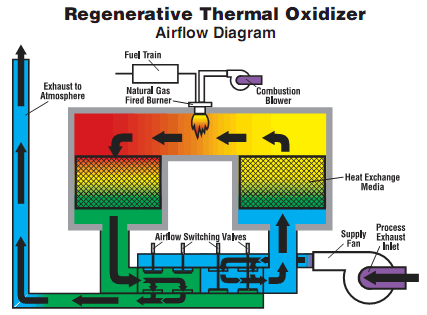
In today’s fast-paced industrial world, air pollution control is no longer optional—it’s a responsibility. From chemical manufacturing to pharmaceuticals, food processing, automotive painting, and petroleum refining, industries across the globe generate volatile organic compounds (VOCs), hazardous air pollutants (HAPs), and odorous gases during production. One of the most reliable and proven technologies to eliminate these emissions is the thermal oxidizer.
A thermal oxidizer (often called an incinerator or combustion oxidizer) is an advanced pollution control device that destroys harmful airborne pollutants using high-temperature oxidation. For decades, it has remained the gold-standard solution for industries seeking compliance, environmental sustainability, and operational safety. But what truly makes thermal oxidizers an indispensable part of modern manufacturing? Let’s dive in.
What Is a Thermal Oxidizer?
A thermal oxidizer is a system engineered to treat industrial exhaust streams by heating them to extremely high temperatures—typically between 760°C and 1,200°C (1,400°F to 2,200°F). At these temperatures, VOCs and HAPs break down into harmless byproducts such as carbon dioxide (CO₂) and water vapor (H₂O).
The process is simple yet powerful:
Polluted air enters the oxidizer.
It is heated in a combustion chamber using natural gas or an alternative fuel.
Harmful compounds oxidize completely.
Clean air exits through the stack.
The main purpose is efficient destruction. Most modern systems achieve 98%–99.9% destruction efficiency, ensuring industries meet strict environmental regulations.
How Thermal Oxidizers Work: The Three-T Principle
Every thermal oxidizer is designed around three essential factors known as the 3 Ts:
1. Temperature
A minimum high temperature is maintained to oxidize VOC molecules. The hotter the chamber, the faster and more complete the conversion.
2. Time (Residence Time)
Pollutants must remain in the chamber long enough—usually 0.5 to 2 seconds—for complete oxidation.
3. Turbulence
Uniform mixing of oxygen, fuel, and pollutants ensures consistent combustion and maximum destruction efficiency.
When these three elements align, the system delivers exceptionally clean exhaust output.
Types of Thermal Oxidizers
Depending on industry needs, thermal oxidizers come in several types:
1. Direct Fired Thermal Oxidizers (DFTOs)
Also known as afterburners, these are the simplest design. Polluted air is directly heated and oxidized without any heat recovery. They are ideal for high-concentration, high-temperature applications.
2. Recuperative Thermal Oxidizers
These units use heat exchangers to recover some of the heat from the clean exhaust gas, making them more energy-efficient.
3. Regenerative Thermal Oxidizers (RTOs)
The most popular and efficient option, RTOs use ceramic heat exchange media to recycle 85%–95% of the heat. They significantly reduce fuel consumption and operational costs.
4. Catalytic Oxidizers
These use a catalyst to promote oxidation at lower temperatures (around 300°C–650°C). They are energy-efficient and ideal for moderate VOC concentrations.
Each type offers unique advantages depending on exhaust characteristics, industry type, and budget.
Why Industries Rely on Thermal Oxidizers
✔ Superior Emission Control
Thermal oxidizers are capable of destroying a wide range of organic pollutants, even in complex and high-volume exhaust streams.
✔ Compliance With Environmental Regulations
With environmental norms becoming stricter, industries cannot risk non-compliance. A thermal oxidizer simplifies regulation by consistently meeting emission standards.
✔ Odor Control
Food processing, rendering plants, and chemical industries often deal with strong odors. Thermal oxidation eliminates odor compounds effectively.
✔ High Energy Efficiency
Especially with regenerative and recuperative systems, energy costs remain low while output efficiency remains high.
✔ Long Operational Life and Reliability
Thermal oxidizers are built for continuous, heavy-duty operation. With proper maintenance, they can reliably perform for decades.
Applications Across Various Industries
Thermal oxidizers serve a wide range of industrial sectors, including:
Chemical manufacturing
Paint and coating operations
Pharmaceutical production
Food processing
Petrochemical plants
Automotive assembly lines
Printing and packaging
Any facility dealing with solvents, resin, adhesives, inks, or combustion fumes benefits immensely from this technology.
Future of Thermal Oxidizers: Smart, Sustainable, and Cost-Effective
As industries shift toward carbon efficiency and green manufacturing, thermal oxidizers are also evolving. Modern systems now include:
Automated oxygen and temperature controls
Heat recovery system integration
Low-NOx burners
Real-time emissions monitoring
IoT-based efficiency optimization
These innovations reduce fuel consumption, enhance environmental performance, and ensure long-term sustainability.
Final Thoughts
A thermal oxidizer is more than just an emission control device—it is a commitment to cleaner air, responsible manufacturing, and global environmental protection. Whether a small-scale facility or a large industrial plant, investing in thermal oxidation technology ensures compliance, efficiency, and peace of mind.
If you’re exploring air treatment options or looking to upgrade your existing system, a thermal oxidizer remains one of the most powerful and future-ready solutions available today.